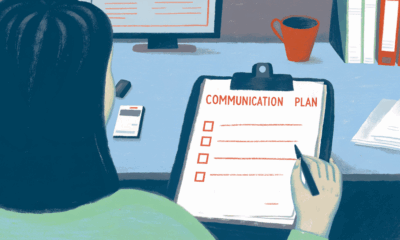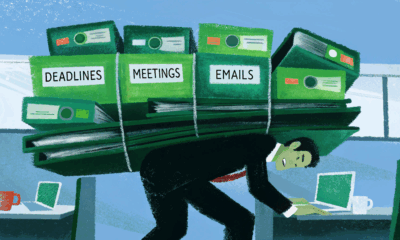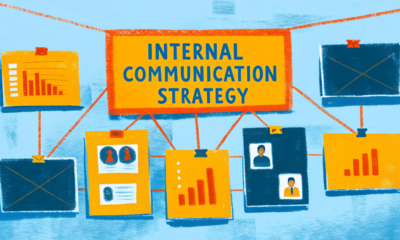Collaboration
How Modern Innovations Revolutionize Digital Workplace

The modern-day workplace has changed so much over the last years, and with every year that passes now, it seems as though these changes are becoming more and more drastic. We’re solidly beginning to say goodbye to the usual 9-5 routine for good, and penned office floors are being replaced with coworking spaces and the comfort of cafés and our own homes.
Technology is fuelling this time of evolution, and it’s incredible to take a minute and see how far we’ve come, yet we can sit in awe with how far we should go. It’s an endless journey and an exciting one at that.
Today, I’m going to talk to you about some of the amazing technologies that are driving the digital workplace revolution happening right now. Whether you’re educating yourself on the latest trends in digital workplace technologies, or looking for ideas on how to take your business to the next level, you’ve come to the right place.
Easing the woes of the commute for Digital Workplace
Nowadays, a day at work starts long before the employee has walked through the entrance to the office. If an employee is remote working, this doesn’t even begin with a commute, because in most cases, there simply isn’t one.
In the digital workplace, technologies such as virtual office workplace software exist to help alleviate the struggles of commuting. For instance, imagine an app that can assist employees in finding available parking spaces in and around your building, or help them quickly locate their assigned desk for the day if your organization has an open-desk policy.
But for remote workers, it doesn’t stop at eliminating the need for commuting. New virtual collaboration tools allow employees to easily “clock in” from anywhere, making it feel as though they are entering a physical office space, even though they’re still at home. These tools are designed to ensure a seamless transition from home to work mode, providing everything from virtual “water cooler” chats to structured meeting spaces, without the need to leave your home.
In the digital workplace, traditional stresses like commuting and parking hassles can be essentially eliminated, leading to a more positive start to the day for employees. This can contribute to increased happiness, productivity, and reduced stress levels, making it easier for employees to perform at their best.
Enhancing and improving the meeting experience
For many businesses, the meeting experience has always been a problem. From having meetings just for the sake of having them and trying to organize them accurately to get people to pay attention and overbooking conference rooms, meetings are the bane of existence for a lot of people.
However, there are plenty of technologies that are aiming to change this. From meeting room booking software that aims to keep everyone in check and meeting room organized all the time, to the technology that aims to keep people engaged with meetings from start to finish, I’m sure we can agree meetings aren’t what they used to be; or at least they’re not in forward-thinking companies.
In the digital workplace, many solutions are available as self-service options. This means that employees can book a meeting right from their computer or a tablet that is conveniently located near the meeting room. Signage is also displayed outside the rooms to avoid unnecessary interruptions.
In addition, artificial intelligence is now playing a significant role in streamlining meetings. AI-based software can automatically schedule meetings based on participants’ availability, send reminders, and even summarize meeting notes, ensuring that no one misses important details. These enhancements make meetings not just easier to manage, but also more productive, as they free up time spent on administrative tasks.
Better collaboration tools for digital workplace
With the rise of instant messaging services, video conferencing platforms, and cloud file-sharing networks, team collaboration in the workplace has never been easier. You can even work with employees on the other side of the world in real-time thanks to this technology.
The digital workplace has revolutionized how we connect and collaborate with others. With instant connectivity, it’s easier than ever to get work done and to do it to a higher quality. Businesses can now hire people from anywhere in the world to fill specific roles, whether on a full-time or freelance basis. They can also easily connect with clients from any location.
When it comes to remote communication, however, one thing remains crucial and that is the area of cybersecurity. The fact that all of our conversations take on a digital form, means that they might get intercepted and exploited a lot easier. That is why it has become especially important to ensure that employees working remotely or from coworking spaces take cybersecurity seriously and do everything in their power to make their accounts secure and breach-proof. It is advisable to use password managers which help users create strong and complex passwords and store them safely.
Furthermore, collaboration tools are increasingly incorporating advanced encryption methods to ensure that communications and files shared between employees are protected from cyber threats. With this added layer of security, businesses can confidently empower their teams to work without worrying about unauthorized access to sensitive information.
It is advisable to implement the principle of least privilege and use password managers which help users create strong and complex passwords and store them safely.
Securing the top talent for your business
The rise of the digital workplace has given younger generations a significant advantage. They have grown up with technology at their fingertips and are often more adept at using it than their older counterparts. As a result, businesses are benefiting from their skills and expertise in navigating the digital landscape.
“When the top talent is entering the workforce, they’re proactively looking for businesses that offer the most up-to-date experience. Young talent doesn’t want to work for old businesses who are stuck in their old, traditional ways, and won’t even interact with businesses who do,” explains Emma Harding, a business writer at OriginWritings.
The implementation of a solid innovation strategy is crucial for the recruitment industry and human resources department to keep up with the changes brought about by technology. Most young talent will now host their own websites to give their portfolios, and would rather connect and apply for a job via a social media network, rather than fill out a form or hand over their CV.
To meet these demands, businesses are adopting more flexible work structures, such as offering hybrid or fully remote positions, which are highly attractive to the younger workforce. They are also leveraging advanced recruitment tools, such as AI-powered platforms, that help match candidates to roles based on skills, experience, and cultural fit, making the hiring process more efficient and effective.
This means that existing businesses need to develop an innovation strategy and change the way they approach their recruitment process. Otherwise, the best talent may not even consider them and opt for companies that are taking a more dynamic and innovative approach.
This is where having an innovation strategy can make all the difference. By actively seeking out new and innovative ways to improve the workplace and employee experience, businesses can not only retain their top talent but also attract new talent. The best and brightest want to work for companies that are pushing the boundaries and constantly improving, so having an innovation strategy can be a key factor in staying competitive in today’s fast-paced business environment.
Rethinking productivity with AI-powered workplace assistants
As businesses compete for top talent and reshape their recruitment strategies to attract a tech-savvy workforce, the conversation no longer ends with hiring. What follows is equally important: providing the right tools that allow employees to thrive in a digital-first environment. This is where AI-powered productivity assistants are quietly reshaping the modern workday.
Rather than replacing human workers, AI tools are increasingly embedded into the flow of daily tasks – responding to messages, prioritizing notifications, preparing meeting summaries, or suggesting edits in real-time. These digital co-workers operate in the background, helping employees manage complexity, reduce manual repetition, and stay focused on work that requires human judgment.
The influence extends beyond task execution. AI is changing how teams communicate, make decisions, and structure their time. Tools that learn from individual and team behavior can now flag burnout risks, identify work pattern inefficiencies, or surface insights from unstructured data that might otherwise go unnoticed.
For HR and hiring managers, this evolution brings new dimensions to how roles are defined. Many new positions are now designed with the assumption that employees will work alongside AI assistants – so adaptability, critical thinking, and the ability to guide or collaborate with AI systems are becoming more important than traditional technical expertise alone.
In this emerging landscape, businesses that equip their people with smart tools not only get more done – they also offer a work experience that aligns with how the next generation expects to work: fast, intuitive, and intelligently supported.
Prioritizing digital well-being in the connected workplace
With smart tools and platforms now embedded into nearly every aspect of the workday, there’s a growing need to ensure that the digital workplace supports – not undermines – employee well-being. As much as technology boosts productivity and flexibility, it can also introduce fatigue, blurred boundaries, and information overload if left unchecked.
Forward-thinking organizations are beginning to approach digital wellness as a design principle, not just a benefit. This means building routines and tools that help employees set boundaries – like systems that batch notifications, suggest focus time based on calendar activity, or encourage breaks when signs of mental fatigue appear.
Equally important is making space for asynchronous work. Not everything requires a Zoom call or instant response, and digital workplaces that support autonomy in how and when people work tend to reduce stress and improve output. From “quiet hours” settings in messaging apps to built-in mindfulness prompts, subtle design choices are starting to play a big role in shaping healthier work cultures.
As the lines between home and office continue to blur, digital ergonomics isn’t just about posture or screen brightness – it’s about designing work in a way that respects human rhythms. Businesses that acknowledge this are not only helping their teams feel better – they’re also building more resilient, sustainable ways of working.
Improving governance and compliance
Businesses need to have a strong innovation strategy to ensure they’re following the law, or else they’re going to end up in a lot of trouble. This is a common problem that affects every business, especially since it can take a lot of time, money, and resources to ensure each business is getting it right.
However, there are plenty of technological solutions out there that are trying to make it better. By embracing innovation and finding new ways to stay compliant, businesses can protect themselves and their employees while staying ahead of the competition.
This is all thanks to the innovative strategy being employed by businesses, governments, and individuals alike. By embracing technology and using it to create more efficient and effective systems, we can ensure that businesses can thrive while staying within the law, and that individuals are held accountable for their actions. Overall, this is an exciting time for innovation and technology, and it’s only going to get better from here.
With the rise of digital tools, many businesses are now using automated compliance systems to track and ensure that all regulations are being met, minimizing human error and saving time. This not only enhances operational efficiency but also reduces the risk of costly legal issues.
This has been proven with the latest COVID-19 outbreak, where governments have been forced to share information quickly with businesses to help save lives. The businesses that were able to adapt and implement innovative solutions were the ones that were able to survive and thrive during the pandemic.
Technology is doing amazing things for this world, and especially the workplace, but it’s up to you to start implementing an innovation strategy, so you can experience the benefits for yourself.
Collaboration
The Power of Collaboration: Exploring the Dynamics of Group Coaching

The working world is changing. And employees know that. But what’s changing goes beyond the ever-growing debate of whether employees should physically return to their workplace.
With the growth of Artificial Intelligence (AI) tools, workplaces are adapting to accommodate the need for new skills, demonstrating the necessity for professional development and coaching in the workplace.
While some may believe AI removes positions, it’s doing the opposite. It’s created jobs and skill sets that haven’t existed before, forming a new landscape for the digital world. The problem isn’t that AI is taking jobs, but that workers are not yet ready for the roles that AI has created.
According to the University of Phoenix’s Annual Career Optimism Index of 2022, 40% of those surveyed said they “worry their job skills will become outdated because of advancements in technology such as automation, artificial intelligence, and robots.” These workers know that the time for upskilling is now. More than half of those surveyed said they must learn new skills within the next year to continue their careers.
And they want to work with employers that recognize that need and offer opportunities to challenge themselves and help them step into the newly-created roles. 68% of those surveyed said they would stay with their employer throughout their career if the employer provided opportunities to upskill.
Professional development is essential for retention, but it’s costly and intimidating for workers.
What is group coaching, and why does it work? Let’s get into how this form of coaching can help your staff upskill.
What is group coaching?
Unsplash.com
Group coaching is a type of professional development where a coach works with a small group to help them learn new skills and reach their goals. During one-on-one coaching, only one employee works with the coach and receives their attention. With group coaching, all members have a common goal. The coach may set aside time to work with each member individually, but they generally meet and work as a group.
What does group coaching look like?
Group coaching can look different depending on the environment. For example, outside the workplace, you may see group coaching as an online course where one coach works through presentations and provides activities to their subscribers.
Group coaching may be more nebulous, with a larger group of people working through the content on a website and coming together to chat about the work, with the content’s creator chiming in to assist.
But in the workplace, group coaching typically involves one expert guiding a group of coworkers through lessons. If you work in an office setting, you might set aside a standard meeting time when the coach and group members can meet in person. Or, if you’re remote, you might set up a video call for presentations and use team collaboration tools to work on activities together.
Ultimately, the main aspect of a group coach that’s always necessary is that everyone in the group is working toward a common goal. That goal helps guide the creation and focus of the coach’s presentations and activities.
Group coaching may be for one team at a time. For example, you might have your company’s teams work in a separate group coaching session. But because group coaching centers around a common goal, you may find that cross-team group coaching is just as beneficial, if not more.
You can survey your employees about what skill sets they want to work on and create groups for coaching based on their answers. This step can help you harness more diverse skill sets on each team and encourage cross-team collaboration.
What are the benefits of group coaching?
1. Prevents silos
Your company is looking to adopt a new AI tool. You have assigned one person as the expert on the application. They know all the ins and outs of how to use it.
But that one expert is the only person who knows how to use it. As a result, the rest of your employees continue to work on more time-consuming processes without realizing how the AI tool could benefit them.
Without realizing it, you’ve created a knowledge silo. Unfortunately, silos are a common part of many workplaces. In addition to knowledge silos, you may also have data silos. One team may store their essential data using one application, while another group may keep theirs somewhere else. All the while, they may not realize that they could benefit from each other’s information. The lack of oversight over each other’s data may also diminish the information’s quality. If these teams aren’t working together, your company may not be using the data optimally.
Group coaching can help stop silos in their tracks. By putting together a group of people who want to reach common goals, you can help them develop essential skills that benefit the whole company.
If you pulled together a group to learn how to use the new AI tool, you would no longer have the issue of just one person who could utilize it. Ultimately, you would save time and resources by allowing more company members to access a tool that would make processes more manageable.
Organizing your group coaching around a common goal rather than simply creating groups according to teams can also facilitate more learning throughout your company. For example, if someone from your marketing, customer success, sales, and software design teams wanted to learn how to use the AI tool, they could bring those learnings back to their groups, spreading the knowledge and further helping the company.
2. Allows collaboration and learning from each other
An expert is an essential part of group coaching. But the group doesn’t just benefit from one person. They also learn from each other.
The coach isn’t just a coach. They are also facilitators. They may teach the group as experts, but they also should facilitate discussions among the group and create activities to promote collaboration.
Say you organized a group coaching session for your newest sales representative. You should develop activities such as researching prospects and developing lead-generation strategies together. In addition, you might have them practice sales calls with each other.
While the coach may be able to offer guidance, the reality is that every person in the group also has something to offer. Each comes with their own experience and background, which they can use to assist each other.
Perhaps one sales representative learned a great tip about engaging a potential customer from their previous company’s sales team lead. They can bring that strategy into the discussion, which their fellow sales representatives can use during their sales calls.
Beyond their experience, working as a team can also help each other see different points of view and learn different problem-solving techniques. For example, if someone struggles to understand a concept, another group member may hold the key to offering an explanation they can comprehend.
3. Develops camaraderie
Beyond collaboration, group coaching also helps coworkers develop trust in each other. By working towards a common goal, the group members can learn who their coworkers are. Ultimately, the time spent together helps them see each other in a new light.
This new camaraderie is an especially valuable part of cross-team group coaching. Generally, a sales team member is likely to spend more time with someone on their team than someone on another team. As a result, most meetings they attend will be with their group; they likely sit around people who also do sales; and they generally know their team dynamics better than their other coworkers.
While doing cross-team group coaching is one way to help prevent silos, it’s also beneficial for developing camaraderie across your company. Trust and fellowship create a healthier, happier, and ideal work environment where people feel listened to and supported, even beyond their team’s boundaries.
4. Diminishes intimidation
No one knows all the answers. But a part of coaching is questioning your employee and asking them to think about solutions. In addition, you want them to develop their problem-solving skills, which means that you can’t just provide them with answers all the time.
But being questioned one-on-one can be intimidating and the opposite of what you want from professional development. You want your employee to come out of professional development feeling more confident and ready to tackle new challenges. But not knowing the answers during one-on-one questioning may make them feel less self-assured.
Group coaching prevents all the attention from falling on one person. During individual coaching, the one person receiving the coaching may get their coach’s undivided attention, but that’s not always a good thing. In a group setting, each member won’t feel they need to know all the answers. They can offer solutions, but they can also spend time listening to coworkers’ responses.
Listening is also part of what makes group coaching so beneficial. By hearing their coworkers’ thought processes, they can develop their listening and retention skills, while also honing the skills they initially came to group coaching to form. And because they’ll feel less intimated, they can focus more on the task rather than being stuck in their heads.
5. Fosters a culture focused on learning
By investing in group coaching, you’re showing your employees that you care about their growth. In a time when people are greatly concerned about upskilling, you want to create a workplace where your employees know that they will continue to advance their skills and, therefore, their careers.
By fostering a culture of learning, you’re demonstrating to your employees that you value them and want to help them face the challenges that may arise as the working world adapts to new tools and technologies. In addition, as the modern working world changes, legacy positions may become obsolete.
But new roles will replace them. Upskilling is one part of the puzzle, but so is reskilling, as your employees may need to develop entirely new skill sets for these roles. Rather than hiring new workers, you can invest in your current employees’ future through professional development, like group coaching.
Your employees want to learn, so it’s up to you to provide them with opportunities. Group coaching helps you develop a company filled with employees honing their skill sets, both professionally and interpersonally. These group members learn from their coach, but they also learn from each other. When you make learning a part of your company values through group coaching, you’re setting your company and each worker up for success.
Are you ready to pump up your group coaching?
Employees are looking to upskill right now. And they’re willing to look for companies that offer the opportunity to develop new skills if their current employer doesn’t.
If you want to retain quality workers, you have to retrain them. With the digital landscape changing constantly, the modern workforce requires new skills.
Investing in professional development is vital to keeping your employees feeling supported, but group coaching goes beyond professional development. With group coaching, you can train more people at once and allow them to learn from an expert in the skill set they want to develop.
Some of the key benefits of group coaching include:
- Preventing silos by sharing knowledge and tools across departments
- Encouraging collaboration through shared experiences
- Strengthening communication, including listening, feedback, and problem-solving skills
- Building camaraderie by connecting people across teams and roles
- Reducing pressure, as group settings often feel less intimidating than one-on-one coaching
- Creating a culture of learning that signals your investment in employee growth
- Promoting skill transfer as new knowledge spreads organically within teams
- Boosting engagement and retention by helping people grow where they work
Beyond skills, group coaching fosters interpersonal connections and breaks down barriers between departments, helping to build a more cohesive and confident workforce.
Through working with new people, you can also help cut down on the development of silos throughout your company. And by using group coaching instead of one-on-one coaching, you can also keep the intimidation levels down, making your employees better, more confident learners.
Learning is precisely what you want to keep at the forefront of your company’s culture. Your employees want to learn. And they want to know that you care about developing their skills and knowledge. A learning culture benefits every aspect of your company and makes your business more likely to be ready to embrace whatever the future holds. As long as you offer opportunities to keep learning and growing through professional development, like group coaching, you’ll be able to prepare your employees for every challenge that comes their way.
Collaboration
18 Experts Share Tips for Businesses Switching to Remote Work

The world is going through a lot right now, with the current outbreak of the coronavirus. Lots of things changed in recent weeks, and most prominently, a lot of companies switched to working remotely. While remote work is far from a novelty, many companies are now giving it a go for the first time just now.
To help out everyone who is dipping their toes in remote working, we’ve gathered a few remote work experts to provide their insights and answer one question:
What is your best piece of advice for companies who are just starting with remote work?
Here are their thoughts.
18 Experts share tips for businesses switching to remote work
DMYTRO OKUNYEV — Founder of Chanty
” It’s essential that you promote a healthy lifestyle, as difficult as that may be. You should be setting time to exercise for all your team members to keep them in shape. There are plenty of benefits to exercising, including improving your overall health.
If you want your team to feel good and perform well, you need them to be healthy and rested so that they can work effectively.
I like to lead by example, so I work out every morning. “
ADAM HEMPENSTALL — CEO and Owner, Better Proposals
” Focus on goals rather than time spent working. The great thing about remote work is that you don’t need to work 8 hours per day.
Instead, give each of your employees a goal and make sure they stick to their outcome. As long as the goal is completed, their work is done for the day. “
MAKSYM BABYCH — CEO at SpdLoad
” The more structured and transparent your processes are, the more rapid your growth is.
It is a huge business advantage to have processes that help your team members hit their goals without undue control. “
MELANIE AMINI — Marketing Director at ScholarshipOwl
” Other than the internet and tech support, it is the most important to have firm, written boundaries for working hours.
Before the WFH life begins, you must set the number of hours they must be online and rules/best practices to follow, but you must also trust your employees.”
KEVIN INDIG — VP SEO & Content at G2.com and Founder of kevin-indig.com
” Do a virtual standup. My teams and I share our top 3 tasks for the day to create alignment and connect. It doesn’t have to be a video call and it doesn’t have to be that long. Just a quick update.
The cool part is that this helps you to focus on what success looks like. It’s not just for others but also yourself. “
KENNY TRINH — CEO of Netbooknews
” Nothing is more important to remote team communication than the team’s digital inbox. Without the ability to have organic, in-person interactions, employees can easily fall victim to “out of sight, out of mind.”
Thus, it’s critical to create a tech stack that provides multiple avenues for communication. “
SHAWN BREYER — Owner of Atlanta House Buyers
” Each week, a full team meeting should be held to review the KPIs of each member.
It makes them feel like they are accountable and they see how other team members should be performing. If there are people who aren’t getting results, the team needs to discuss if it is goal, team or resources related.
When that person or the team finds if the trend is that no one ever meets their goals, the leadership needs to determine if people are lacking training and resources or if they are not a good fit for the team.“
DARREN VIRASSAMMY — Co-Founder and COO, 34 Strong
” Make sure to have your 1-1s with each team member. Use this disruption as a chance to pause, evaluate what really matters, and grow as a manager. Each shift has to get the team focused on what’s still strong.
There’s an opportunity to realign the team’s work with core values. It’s a chance to strengthen the rhythm for completing work and keeping team members engaged during these unprecedented times. “
CATHY DECKER — Co-founder and Principal Decker/Royal
” Don’t micro-manage, don’t call unexpectedly to time how long it takes to answer the phone, and don’t plan unnecessary meetings. Hold your team members accountable to their deliverables, and then allow them to do their jobs. “
ANH TRINH — Managing Editor, GeekWithLaptop
” Ask an experienced co-worker to show the ropes to the rest of the team. Having someone who knows the ins and outs of the remote work environment can quickly instruct members on how to work properly and productively within a week or so is a great way to get started. “
BRET BONNET — Co-Founder/President, Quality Logo Products
” Be ready to work twice as hard. Make as many team projects as possible, even if they don’t have to be. The more opportunities to work together, the less likely team members are to feel disconnected and the more productive they’ll be! “
MONICA EATON-CARDONE — Co-Founder and COO, Chargebacks911
” Make sure that any individual working from home feels supported. It’s important to remember that even though your employees are not physically in the office, the communication line ought to remain open. “
KATARZYNA IWANICH — Co-Founder, Insightland
” Keep a written agenda such as online schedule with a list of online meetings and tasks for specific days. It helps to plan your job and be efficient in time management.
At the same time, if the team gets stuck with some part of the process, working with deadlines gets easier. “
MARK WEBSTER — Co-Founder, Authority Hacker
” The first thing to do is to get everyone aligned to a strict “communication time.” The thing is, distractions are normal at home.
It’s important to synchronize and have a non-stop 8–10 AM slot every day (or week, whatever suits your team) for the team to be online, available and present for anything that occurs on a day to day basis. “
BEN TAYLOR — Founder, Home Working Club
” My main piece of advice is to trust your team and don’t introduce rules for the sake of it. If you’ve recruited and managed people well, trust shouldn’t be an issue.
Some excuses are generated reasons for things like enforcing instant logins or using screen monitoring software. DON’T DO THESE THINGS.”
ANGELA PEACOCK — CEO, PDT Global
” Recognize that the fears of your employees may not be the same as yours. While you are worried about productivity and how to keep your business alive through this strange time, some of your staff might be worried their children won’t get into school shot during the next year. Others among them may also be anxious about whether the technology is going to let them down and they won’t be able to work. “
JARRED KESSLER — CEO and Founder, EasyKnock
” Use the time to exercise your brain and your health. It’s a huge stress reliever and keeps your immune system boosted.
Go outside if you live alone and pick up the phone if you live with others. If you interact with a loved one once a week at a minimum, you keep your brain more alive than ever. Ask them how they are doing live.”
TAPAN PATEL — Co-founder, Third Rock Techno
” For a smooth transition to a culture of remote working, facilitate time communication. Ensure that your team is equipped with a proper computer and high-speed internet at home.
Help them get all the resources they need to collaborate with each other efficiently. Clearly explain to the team the processes that you plan to follow while everyone is working remotely. “
Conclusion
If you and your company are new to remote work, don’t get scared away by the few challenges it has. Instead, focus on the many positives and you will see that you and your company can be just as productive when working remotely, if not even more. If you have any tips besides the one shared above, please share them with us in the comments to this post.
Collaboration
4 Common Problems of Virtual Teams are Solved

Low-stress level, no commute, no shoes, PJs only, spending more time with family and friends, and so much more. Sounds neat right? According to some studies, remote work has brought higher productivity and a more positive work-life balance since the beginning of the pandemic. However, it’s not all rainbows and butterflies, is it? We have been facing some challenges, to say the least. We struggle with unplugging ourselves once the work is done for the day, we need our office gossip, and even though we don’t need to wear shoes, we still kinda miss them. Many problems can appear when we are managing virtual teams. However, does that mean we cannot ace a video meeting or have the same level of communication with our teammates as we did before? Never! All we have to do is get our hands to the right collaboration tools to manage our virtual teams. I give to you the solutions to the most common problems we’ve faced working from home. Trust me, it really is as easy as pie!
1. Communication breakdown: it’s not all about messages — it’s about meaning
The one most reported problem of remote teams is communication — or the lack of it. But it has nothing to do with missed messages. It has everything to do with lost context.
When you communicate face-to-face, 70–90% of what you intend is communicated through body language, tone of voice, and facial expressions. Remote workers lack that level. An urgent message meant to be productive will be cold. A wait in responding will be perceived as not caring.
That’s why business communications tools like Chanty, Google Chat, and GoToMeeting aren’t nice-to-haves, they’re must-haves. They facilitate teams to communicate in real-time, clarify their communication, and utilize richer media like voice and video. Still, the best tool is nothing without a shared communication culture.
HR comes into play here. Get teams to figure out how they communicate: messaging vs. meeting, how they handle urgency, and what “offline” means. Prioritize making voice notes and camera-on calls the new normal to bring back that human feel.
Communication isn’t only about words. It’s about being heard — and feeling connected.
2. Collaboration without clarity: the hidden cost of scattered work
In an office, things naturally tend to overlap. You stretch over a desk. You cut off someone at the coffee machine. You interpret a face at a brainstorming session.
In virtual teams, it doesn’t happen. And without the proper tools, folks will naturally feel like they’re working in solitude — despite being part of a team.
This is where Google Workspace, Microsoft 365, Dropbox, and OneDrive come in. These apps are not simply storage devices — they create a virtual workspace where collaborators can work together. Teams can work together on docs, comment in real-time, and have one source of truth.
But what really matters is psychological safety. If employees don’t feel free to give each other working drafts or ask for help, technology can’t fix that. HR leaders must create a space where collaboration means learning alongside one another, not just working alongside one another.
Technology reduces the friction. But humans reduce the fear. That’s how collaboration thrives.
3. Remote project confusion: why visibility matters more than ever
Without structure, remote projects can drift. Deadlines are missed. Jobs get blurry. Team members do not know what others are doing — or what they must do.
Project management tools like Asana, Jira, Basecamp, and SmartTask bring much-needed discipline. They break goals into doable pieces. They delegate tasks. They provide timelines and certainty.
But aside from task management, these sites are emotional clarity tools. When everyone can see who’s working on what, stress goes down. Nobody feels like they’re doing it all themselves. Nobody feels ignored. Transparency is peace of mind.
For HR, it’s a golden opportunity. Utilize these tools not just for productivity — but for inclusion. A reserved junior team member during meetings can spring to life when they are given clear guidance in a task board. A mute struggler might reveal to us their stress in overdue assignments.
Project management tools have secrets. Savvy HR teams listen intently.
4. Time and productivity tracking: from surveillance to self-awareness
Time tracking is one of the more controversial aspects of remote work. Done badly, it’s intrusive. Done well, it’s an amazing wellness and performance tool.
TimeDoctor, Hivedesk, Toggl, and PomoDone are some of the applications that enable teams to see how they spend their time. They show data on attention, idleness, and task-switching. To remote teams, this isn’t accountability — it’s awareness.
Most remote workers struggle to “switch off.” They work longer, take shorter breaks, and quietly burn out. HR can use time-tracking data not as a punisher, but as a protector. Recognizing overwork early is an act of care.
Furthermore, these tools empower people. People can look at when they’re most productive, or where they drift off course. They can set their own schedules, and build better habits.
The true value isn’t in tracking time — it’s in getting time to work more effectively for individuals.
Final Thought
No matter how many tools you bring on board, virtual teams will fail if their human needs are not met. The need to connect. To be seen. To understand. To trust.
Which makes HR’s role so critical. You’re not just choosing software —you’re developing culture. When you combine great tools with compassionate leadership, you don’t just solve issues — you create an environment where remote doesn’t equal removed.
Because in the end, remote teams don’t succeed because of technology.
They succeed because they care.
-

 Communication3 months ago
Communication3 months ago6 Communication Plan Templates With Examples
-

 Collaboration3 months ago
Collaboration3 months ago6 Tips for Lifting the Burden of Too Many Responsibilities
-

 Collaboration2 months ago
Collaboration2 months ago30 Work From Home Memes: Funny Work Memes to Make You Laugh
-

 Collaboration4 months ago
Collaboration4 months ago35+ Collaboration Quotes to Celebrate Teamwork
-

 Collaboration3 months ago
Collaboration3 months agoThe Definitive Guide to Creating an Internal Communication Strategy
-

 Productivity2 months ago
Productivity2 months agoSuper True Mental Health Memes You’ll Probably Relate To
-

 Collaboration3 months ago
Collaboration3 months ago7 Easy Strategies for Effective Team Communication
-

 Productivity3 months ago
Productivity3 months agoWhat is Imposter Syndrome and How to Overcome It?









